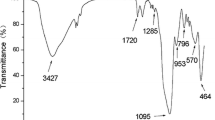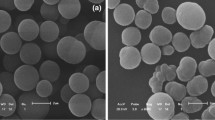Abstract
A magnetic molecularly imprinted polymer (MMIP) was successfully synthesized and applied as the sorbent in the magnetic dispersive solid-phase microextraction (MDSPME) to separate and preconcentrate diazinon from real samples prior to its determination by high-performance liquid chromatography with ultraviolet detector (HPLC-UV). The MMIP was prepared by one-step surface imprinting technique using precipitation polymerization method without any use of surfactants or stabilizers. The functionalized Fe3O4 nanoparticles were used as the magnetic supporter, diazinon as the template, methacrylic acid (MAA) as the functional monomer, and ethylene glycol dimethacrylate (EGDMA) as the cross-linker. The synthesized MMIP was characterized by Fourier transform infrared (FT-IR) spectroscopy, scanning electron microscopy (SEM), X-ray diffraction (XRD) spectroscopy, and Brunauer–Emmett–Teller (BET) analysis. The selectivity study demonstrated that the MMIP had high affinity toward diazinon compared to other organophosphates (fenitrothion and chlorpyrifos). Various parameters affecting the efficiency of extraction such as sorption and desorption time, amount of sorbent, type and volume of eluting solvent, and pH were investigated and optimized. Under the optimum conditions, the calibration graph was linear over the range of 0.07–30.0 μg L−1 with the limit of detection of 0.02 μg L−1. The relative standard deviations (RSDs) at the 0.1 and 10.0 μg L−1 levels of diazinon (n = 5) were 3.8 and 2.0 %, respectively. The proposed method was successfully applied to the determination of trace amount of diazinon in tomato, cucumber, apple, and well water samples.







Similar content being viewed by others
References
Araújo CS, Alves VN, Rezende HC, Coelho NM (2010) Development of a flow system for the determination of low concentrations of silver using Moringa oleifera seeds as biosorbent and flame atomic absorption spectrometry. Microchem J 96:82–85
Bagheri H, Ayazi Z, Sistani H (2011) Chemically bonded carbon nanotubes on modified gold substrate as novel unbreakable solid phase microextraction fiber. Microchim Acta 174:295–301
Baldim IM, de Oliveira Souza MC, da Cunha Souza JCJ, Figueiredo EC, Martins I (2012) Application of the molecularly imprinted solid-phase extraction to the organophosphate residues determination in strawberries. Anal Bioanal Chem 404:1959–1966
Bayat M, Hassanzadeh-Khayyat M, Mohajeri SA (2015) Determination of diazinon pesticide residue in tomato fruit and tomato paste by molecularly imprinted solid-phase extraction coupled with liquid chromatography analysis. Food Anal Methods 8:1034–1041
Behbahani M, Salarian M, Bagheri A, Tabani H, Omidi F, Fakhari A (2014) Synthesis, characterization and analytical application of Zn (II)-imprinted polymer as an efficient solid-phase extraction technique for trace determination of zinc ions in food samples. J Food Compos Anal 34:81–89
Berhanu T, Megersa N, Solomon T, Jönsson JÅ (2008) A novel equilibrium extraction technique employing hollow fibre liquid phase microextraction for trace enrichment of freely dissolved organophosphorus pesticides in environmental waters. Int J Environ Anal Chem 88:933–945
Codex pesticides residues in food online database CAC, 22nd, Session (1997). http://www.codexalimentarius.net/mrls/pestdes/jsp/pest_qe.jsp (accessed on 09.01.2011)
Cacho C, Turiel E, Pérez-Conde C (2009) Molecularly imprinted polymers: an analytical tool for the determination of benzimidazole compounds in water samples. Talanta 78:1029–1035
Camino-Sánchez F, Zafra-Gómez A, Ruiz-García J, Vílchez J (2013) Screening and quantification of 65 organic pollutants in drinking water by stir bar sorptive extraction-gas chromatography-triple quadrupole mass spectrometry. Food Anal Methods 6:854–867
Chang L, Chen S, Li X (2012) Synthesis and properties of core-shell magnetic molecular imprinted polymers. Appl Surf Sci 258:6660–6664
Chen L, Liu J, Zeng Q, Wang H, Yu A, Zhang H, Ding L (2009) Preparation of magnetic molecularly imprinted polymer for the separation of tetracycline antibiotics from egg and tissue samples. J Chromatogr A 1216:3710–3719
Chen L, Xu S, Li J (2011) Recent advances in molecular imprinting technology: current status, challenges and highlighted applications. Chem Soc Rev 40:2922–2942
Coscollà C, Castillo M, Pastor A, Yusà V (2011) Determination of 40 currently used pesticides in airborne particulate matter (PM 10) by microwave-assisted extraction and gas chromatography coupled to triple quadrupole mass spectrometry. Anal Chim Acta 693:72–81
Drufovka K, Danevčič T, Trebše P, Stopar D (2008) Microorganisms trigger chemical degradation of diazinon. Int Biodeterior Biodegrad 62:293–296
Farajzadeh MA, Bahram M, Vardast MR, Bamorowat M (2011) Dispersive liquid-liquid microextraction for the analysis of three organophosphorus pesticides in real samples by high performance liquid chromatography-ultraviolet detection and its optimization by experimental design. Microchim Acta 172:465–470
Garcia R, Cabrita MJ, Freitas AMC (2011) Application of molecularly imprinted polymers for the analysis of pesticide residues in food—a highly selective and innovative approach. Am J Anal Chem 2:16–25
Ghaedi M, Ansari A, Habibi M, Asghari A (2014) Removal of malachite green from aqueous solution by zinc oxide nanoparticle loaded on activated carbon: kinetics and isotherm study. J Ind Eng Chem 20:17–28
Hassanzadeh N, Bahramifar N, Esmaili‐Sari A (2010) Residue content of carbaryl applied on greenhouse cucumbers and its reduction by duration of a pre‐harvest interval and post‐harvest household processing. J Sci Food Agric 90:2249–2253
He C, Long Y, Pan J, Li K, Liu F (2007) Application of molecularly imprinted polymers to solid-phase extraction of analytes from real samples. J Biochem Biophys Methods 70:133–150
He Z, Liu D, Li R, Zhou Z, Wang P (2012) Magnetic solid-phase extraction of sulfonylurea herbicides in environmental water samples by Fe3O4@dioctadecyl dimethyl ammonium chloride@silica magnetic particles. Anal Chim Acta 747:29–35
Hu Y, Li Y, Liu R, Tan W, Li G (2011) Magnetic molecularly imprinted polymer beads prepared by microwave heating for selective enrichment of β-agonists in pork and pig liver samples. Talanta 84:462–470
Ji Y, Yin J, Xu Z, Zhao C, Huang H, Zhang H, Wang C (2009) Preparation of magnetic molecularly imprinted polymer for rapid determination of bisphenol A in environmental water and milk samples. Anal Bioanal Chem 395:1125–1133
Jia G, Lv C, Zhu W, Qiu J, Wang X, Zhou Z (2008) Applicability of cloud point extraction coupled with microwave-assisted back-extraction to the determination of organophosphorous pesticides in human urine by gas chromatography with flame photometry detection. J Hazard Mater 159:300–305
Kang HG, Jeong SH, Cho JH, Kim DG, Park JM, Cho MH (2004) Chlropyrifos-methyl shows anti-androgenic activity without estrogenic activity in rats. Toxicology 199:219–230
Kazemi E, Shabani AMH, Dadfarnia S (2015) Synthesis and characterization of a nanomagnetic ion imprinted polymer for selective extraction of silver ions from aqueous samples. Microchim Acta 182:1025–1033
Kosikowska M, Biziuk M (2010) Review of the determination of pesticide residues in ambient air. TrAC Trends Anal Chem 29:1064–1072
Kristenson E, Shahmiri S, Slooten C, Vreuls R, Brinkman UT (2004) Matrix solid-phase dispersion micro-extraction of pesticides from single insects with subsequent GC–MS analysis. Chromatographia 59:315–320
Li L, He X, Chen L, Zhang Y (2009) Preparation of core‐shell magnetic molecularly imprinted polymer nanoparticles for recognition of bovine hemoglobin. Chem Asian J 4:286–293
Lu AH, Salabas EL, Schüth F (2007) Magnetic nanoparticles: synthesis, protection, functionalization, and application. Angew Chem Int Ed 46:1222–1244
Lu F, Li H, Sun M, Fan L, Qiu H, Li X, Luo C (2012) Flow injection chemiluminescence sensor based on core–shell magnetic molecularly imprinted nanoparticles for determination of sulfadiazine. Anal Chim Acta 718:84–91
Maddy K, Knaak J, Gibbons D (1986) Monitoring the urine of pesticide applicators in California for residues of chlordimeform and its metabolites 1982–1985. Toxicol Lett 33:37–44
Maroni M, Catenacci G, Galli D, Cavallo D, Ravazzani G (1990) Biological monitoring of human exposure to acephate. Arch Environ Contam Toxicol 19:782–788
Norman KN, Panton SH (2001) Supercritical fluid extraction and quantitative determination of organophosphorus pesticide residues in wheat and maize using gas chromatography with flame photometric and mass spectrometric detection. J Chromatogr A 907:247–255
Ojeda CB, Rojas FS (2009) Separation and preconcentration by dispersive liquid–liquid microextraction procedure: a review. Chromatographia 69:1149–1159
Pan J, Xu L, Dai J, Li X, Hang H, Huo P, Li C, Yan Y (2011) Magnetic molecularly imprinted polymers based on attapulgite/Fe3O4 particles for the selective recognition of 2, 4-dichlorophenol. Chem Eng J 174:68–75
Pebdani AA, Shabani AMH, Dadfarnia S, Khodadoust S (2015) Solid phase microextraction of diclofenac using molecularly imprinted polymer sorbent in hollow fiber combined with fiber optic-linear array spectrophotometry. Spectrochim Acta, Part A 147:26–30
Peng-Ju W, Jun Y, Qing-De S, Yun G, Xiao-Lan Z, Ji-Bao C (2007) Rapid removal of template from molecularly imprinted polymers by accelerated solvent extraction. Chin J Anal Chem 35:484–488
Ravelo‐Pérez LM, Hernández‐Borges J, Ángel Rodríguez‐Delgado M (2008) Multiwalled carbon nanotubes as solid‐phase extraction materials for the gas chromatographic determination of organophosphorus pesticides in waters. J Sep Sci 31:3612–3619
Roosta M, Ghaedi M, Shokri N, Daneshfar A, Sahraei R, Asghari A (2014) Optimization of the combined ultrasonic assisted/adsorption method for the removal of malachite green by gold nanoparticles loaded on activated carbon: experimental design. Spectrochim Acta, Part A 118:55–65
Sadeghi S, Aboobakri E (2012) Magnetic nanoparticles with an imprinted polymer coating for the selective extraction of uranyl ions. Microchim Acta 178:89–97
Sanagi MM, Salleh S, Ibrahim WAW, Naim AA, Hermawan D, Miskam M, Hussain I, Aboul-Enein HY (2013) Molecularly imprinted polymer solid-phase extraction for the analysis of organophosphorus pesticides in fruit samples. J Food Compos Anal 32:155–161
Sanghi R, Tewari V (2001) Monitoring of pesticide residues in summer fruits and vegetables from Kanpur. India Bull Environ Contam Toxicol 67:587–593
Shakerian F, Dadfarnia S, Shabani AMH, Rohani M (2008) MultiSimplex optimization of on-line sorbent proconcentration and determination of iron by FI-AAS and microcolumn of immobilized ferron. Talanta 77:551–555
Tse Sum Bui B, Haupt K (2010) Molecularly imprinted polymers: synthetic receptors in bioanalysis. Anal Bioanal Chem 398:2481–2492
Vasilić Ž, Štengl B, Drevenkar V (1999) Dimethylphosphorus metabolites in serum and urine of persons poisoned by malathion or thiometon. Chem Biol Interact 119:479–487
Volante M, Galarini R, Miano V, Cattaneo M, Pecorelli I, Bianchi M, Marinoni M, Cossignani L, Damiani P (2001) A SPME-GC-MS approach for antivarroa and pesticide residues analysis in honey. Chromatographia 54:241–246
Wagner E, McMillan S, Plewa M (2005) Cytotoxicity of organophosphorus ester (OP) insecticides and cytotoxic synergism of 2-acetoxyacetylaminofluorene (2AAAF) in Chinese hamster ovary (CHO) cells. Bull Environ Contam Toxicol 75:329–334
Wang X, Wang L, He X, Zhang Y, Chen L (2009) A molecularly imprinted polymer-coated nanocomposite of magnetic nanoparticles for estrone recognition. Talanta 78:327–332
Wang Y-L, Gao Y-L, Wang P-P, Shang H, Pan S-Y, Li X-J (2013) Sol–gel molecularly imprinted polymer for selective solid phase microextraction of organophosphorous pesticides. Talanta 115:920–927
Xu S, Lu H, Zheng X, Chen L (2013) Stimuli-responsive molecularly imprinted polymers: versatile functional materials. J Mater Chem C 1:4406–4422
Xu S, Guo C, Li Y, Yu Z, Wei C, Tang Y (2014) Methyl parathion imprinted polymer nanoshell coated on the magnetic nanocore for selective recognition and fast adsorption and separation in soils. J Hazard Mater 264:34–41
Yuan L, Ma J, Ding M, Wang S, Wu X, Li Y, Ma K, Zhou X, Li F (2012) Preparation of estriol–molecularly imprinted silica nanoparticles for determining oestrogens in milk tablets. Food Chem 131:1063–1068
Zare F, Ghaedi M, Daneshfar A, Ostovan A (2015) Magnetic molecularly imprinted polymer for the efficient and selective preconcentration of diazinon before its determination by high‐performance liquid chromatography. J Sep Sci 38:2797–2803
Zhang Y, Liu R, Hu Y, Li G (2009) Microwave heating in preparation of magnetic molecularly imprinted polymer beads for trace triazines analysis in complicated samples. Anal Chem 81:967–976
Zhang L, Wang Y, Sun C, Yang S, He H (2013) Simultaneous determination of organochlorine, organophosphorus, and pyrethroid pesticides in bee pollens by solid-phase extraction cleanup followed by gas chromatography using electron-capture detector. Food Anal Methods 6:1508–1514
Author information
Authors and Affiliations
Corresponding author
Ethics declarations
Funding
This study was not funded by any organization.
Conflict of Interest
Alireza Bazmandegan-Shamili declares that he has no conflict of interest. Shayessteh Dadfarnia declares that she has no conflict of interest. Ali Mohammad Haji Shabani declares that he has no conflict of interest. Mahboubeh Saeidi declares that she has no conflict of interest. Masoud Rohani Moghadam declares that he has no conflict of interest.
Ethical approval
This article does not contain any studies with human participants and animal subjects.
Informed consent
Not applicable to this study.
Rights and permissions
About this article
Cite this article
Bazmandegan-Shamili, A., Dadfarnia, S., Haji Shabani, A.M. et al. High-Performance Liquid Chromatographic Determination of Diazinon after Its Magnetic Dispersive Solid-Phase Microextraction Using Magnetic Molecularly Imprinted Polymer. Food Anal. Methods 9, 2621–2630 (2016). https://doi.org/10.1007/s12161-016-0456-z
Received:
Accepted:
Published:
Issue Date:
DOI: https://doi.org/10.1007/s12161-016-0456-z




